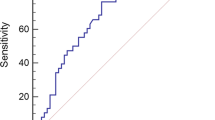Abstract
Background and Aim
25-Hydroxyvitamin D [25(OH)D] has an important role in fibrosis progression and inflammatory response in patients with various etiologies of chronic liver disease. However, its influence on autoimmune hepatitis (AIH) has not been investigated. We evaluated the association of serum 25(OH)D levels with clinical, biochemical and histological features and response to therapy in AIH.
Materials and methods
Serum 25(OH)D levels were quantified in 68 therapy naïve AIH patients and 34 healthy controls.
Results
Mean serum 25(OH)D levels were significantly lower in AIH compared to healthy controls (16.8 ± 9.2 vs. 35.7 ± 13.6, p < 0.0001). Low levels of 25(OH)D (<30 µg/L) were independently associated with advance fibrosis and severe interface hepatitis in AIH patients [p = 0.014; odds ratio (OR) 0.12, 95 % confidence interval (CI) 0.02–0.65 and p = 0.020; OR 0.17, 95 % CI 0.04–0.76, respectively]. Severe 25(OH)D deficiency (<10 µg/L) was associated with advance fibrosis, severe interface hepatitis, low platelet counts and sampling time in a univariate analysis. Only interface hepatitis and fibrosis scores were independently associated with 25(OH)D deficiency in a multiple regression analysis (p = 0.005; OR 0.12, 95 % CI 0.03–0.53 and p = 0.022; OR 0.15, 95 % CI 0.03–0.75, respectively). Mean serum 25(OH)D levels were lower in non-responders compared to responders (9.2 ± 4.8 vs. 17.1 ± 9.4, p = 0.015), and 25(OH)D deficiency was more commonly observed in non-responders than the responders (80 vs. 43 %, p = 0.036).
Conclusions
Low 25(OH)D levels are associated with advance fibrosis and severe inflammation in AIH. Our study suggests that vitamin D may be a potential biomarker that predicts response to therapy and histological features in AIH.



Similar content being viewed by others
References
Krawitt EL. Autoimmune hepatitis. N Engl J Med. 2006;354:54–66.
Vergani D, Longhi MS, Bogdanos DP, et al. Autoimmune hepatitis. Semin Immunopathol. 2009;31:421–435.
Efe C, Ozaslan E, Wahlin S, et al. Antibodies to soluble liver antigen in patients with various liver diseases: a multicentre study. Liver Int. 2013;33:190–196.
Alvarez F, Berg PA, Bianchi FB, et al. International autoimmune hepatitis group report: review of criteria for diagnosis of autoimmune hepatitis. J Hepatol. 1999;31:929–938.
Hennes EM, Zeniya M, Czaja AJ, et al. Simplified criteria for the diagnosis of autoimmune hepatitis. Hepatology. 2008;48:169–176.
Manns MP, Czaja AJ, Gorham JD, et al. Diagnosis and management of autoimmune hepatitis. Hepatology. 2010;51:2193–2213.
Liberal R, Longhi MS, Mieli-Vergani G, et al. Pathogenesis of autoimmune hepatitis. Best Pract Res Clin Gastroenterol. 2011;25:653–664.
Smyk DS, Orfanidou T, Invernizzi P, et al. Vitamin D in autoimmune liver disease. Clin Res Hepatol Gastroenterol. 2013;37:535–545.
Arnson Y, Amital H, Shoenfeld Y. Vitamin D and autoimmunity: new aetiological and therapeutic considerations. Ann Rheum Dis. 2007;66:1137–1142.
Stokes CS, Volmer DA, Grunhage F, et al. Vitamin D in chronic liver disease. Liver Int. 2013;33:338–352.
Stokes CS, Krawczyk M, Reichel C, et al. Vitamin D deficiency is associated with mortality in patients with advanced liver cirrhosis. Eur J Clin Invest. 2013. doi:10.1111/eci.12205.
Dasarathy J, Periyalwar P, Allampati S, et al. Hypovitaminosis D is associated with increased whole body fat mass and greater severity of non-alcoholic fatty liver disease. Liver Int. 2013. doi:10.1111/liv.12312.
Petta S, Camma C, Scazzone C, et al. Low vitamin D serum level is related to severe fibrosis and low responsiveness to interferon-based therapy in genotype 1 chronic hepatitis C. Hepatology. 2010;51:1158–1167.
Farnik H, Bojunga J, Berger A, et al. Low vitamin D serum concentration is associated with high levels of hepatitis B virus replication in chronically infected patients. Hepatology. 2013;58:1270–1276.
Holick MF, Binkley NC, Bischoff-Ferrari HA, et al. Evaluation, treatment, and prevention of vitamin D deficiency: an Endocrine Society clinical practice guideline. J Clin Endocrinol Metab. 2011;96:1911–1930.
Bedossa P, Poynard T. An algorithm for the grading of activity in chronic hepatitis C. The METAVIR Cooperative Study Group. Hepatology. 1996;24:289–293.
Vogel A, Strassburg CP, Manns MP. Genetic association of vitamin D receptor polymorphisms with primary biliary cirrhosis and autoimmune hepatitis. Hepatology. 2002;35:126–131.
Trépo E, Ouziel R, Pradat P, et al. Marked 25-hydroxyvitamin D deficiency is associated with poor prognosis in patients with alcoholic liver disease. J Hepatol. 2013;59:344–350.
Ma Y, Longhi MS, Bogdanos DP, et al. 17 Functional impairment of CD25+CD4+ regulatory T cells characterizes autoimmune hepatitis type 2. Hepatology. 2003;38:163.
Efe C, Purnak T, Ozaslan E. Anti TNF-alpha therapy can be a novel treatment option in patients with autoimmune hepatitis. Aliment Pharmacol Ther. 2010;32:115.
Weiler-Normann C, Schramm C, Quaas A, et al. Infliximab as a rescue treatment in difficult-to-treat autoimmune hepatitis. J Hepatol. 2013;58:529–534.
Conflict of interest
None.
Author information
Authors and Affiliations
Corresponding author
Rights and permissions
About this article
Cite this article
Efe, C., Kav, T., Aydin, C. et al. Low Serum Vitamin D Levels Are Associated with Severe Histological Features and Poor Response to Therapy in Patients with Autoimmune Hepatitis. Dig Dis Sci 59, 3035–3042 (2014). https://doi.org/10.1007/s10620-014-3267-3
Received:
Accepted:
Published:
Issue Date:
DOI: https://doi.org/10.1007/s10620-014-3267-3




